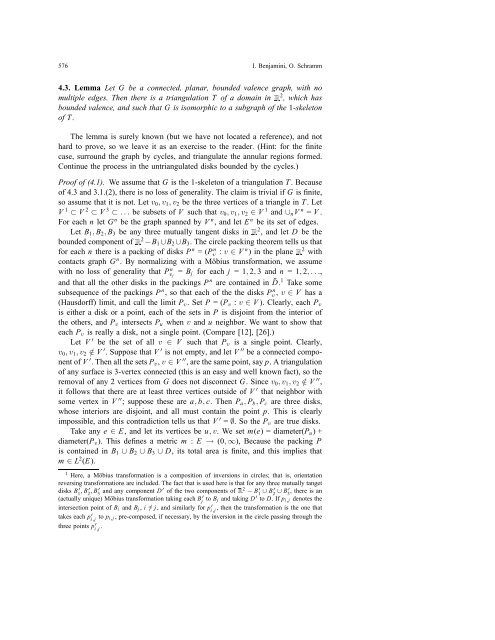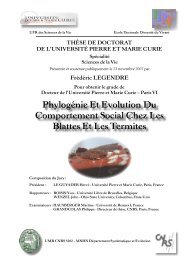Harmonic functions on planar and almost planar graphs and ...
Harmonic functions on planar and almost planar graphs and ...
Harmonic functions on planar and almost planar graphs and ...
You also want an ePaper? Increase the reach of your titles
YUMPU automatically turns print PDFs into web optimized ePapers that Google loves.
576 I. Benjamini, O. Schramm4.3. Lemma Let G be a c<strong>on</strong>nected, <strong>planar</strong>, bounded valence graph, with nomultiple edges. Then there is a triangulati<strong>on</strong> T of a domain in R 2 , which hasbounded valence, <strong>and</strong> such that G is isomorphic to a subgraph of the 1-skelet<strong>on</strong>of T .The lemma is surely known (but we have not located a reference), <strong>and</strong> nothard to prove, so we leave it as an exercise to the reader. (Hint: for the finitecase, surround the graph by cycles, <strong>and</strong> triangulate the annular regi<strong>on</strong>s formed.C<strong>on</strong>tinue the process in the untriangulated disks bounded by the cycles.)Proof of (4.1). We assume that G is the 1-skelet<strong>on</strong> of a triangulati<strong>on</strong> T . Becauseof 4.3 <strong>and</strong> 3.1.(2), there is no loss of generality. The claim is trivial if G is finite,so assume that it is not. Let v 0 ,v 1 ,v 2 be the three vertices of a triangle in T . LetV 1 ⊂ V 2 ⊂ V 3 ⊂ ... be subsets of V such that v 0 ,v 1 ,v 2 ∈V 1 <strong>and</strong> ∪ n V n = V .For each n let G n be the graph spanned by V n , <strong>and</strong> let E n be its set of edges.Let B 1 , B 2 , B 3 be any three mutually tangent disks in R 2 , <strong>and</strong> let D be thebounded comp<strong>on</strong>ent of R 2 −B 1 ∪B 2 ∪B 3 . The circle packing theorem tells us thatfor each n there is a packing of disks P n =(P n v :v∈V n ) in the plane R 2 withc<strong>on</strong>tacts graph G n . By normalizing with a Möbius transformati<strong>on</strong>, we assumewith no loss of generality that P n v j= B j for each j =1,2,3 <strong>and</strong> n =1,2,...,<strong>and</strong> that all the other disks in the packings P n are c<strong>on</strong>tained in ¯D. 1 Take somesubsequence of the packings P n , so that each of the the disks P n v , v ∈ V has a(Hausdorff) limit, <strong>and</strong> call the limit P v . Set P =(P v :v∈V). Clearly, each P vis either a disk or a point, each of the sets in P is disjoint from the interior ofthe others, <strong>and</strong> P v intersects P u when v <strong>and</strong> u neighbor. We want to show thateach P v is really a disk, not a single point. (Compare [12], [26].)Let V ′ be the set of all v ∈ V such that P v is a single point. Clearly,v 0 ,v 1 ,v 2 /∈V ′ . Suppose that V ′ is not empty, <strong>and</strong> let V ′′ be a c<strong>on</strong>nected comp<strong>on</strong>entof V ′ . Then all the sets P v , v ∈ V ′′ , are the same point, say p. A triangulati<strong>on</strong>of any surface is 3-vertex c<strong>on</strong>nected (this is an easy <strong>and</strong> well known fact), so theremoval of any 2 vertices from G does not disc<strong>on</strong>nect G. Since v 0 ,v 1 ,v 2 /∈V ′′ ,it follows that there are at least three vertices outside of V ′ that neighbor withsome vertex in V ′′ ; suppose these are a, b, c. Then P a , P b , P c are three disks,whose interiors are disjoint, <strong>and</strong> all must c<strong>on</strong>tain the point p. This is clearlyimpossible, <strong>and</strong> this c<strong>on</strong>tradicti<strong>on</strong> tells us that V ′ = ∅. SotheP v are true disks.Take any e ∈ E, <strong>and</strong> let its vertices be u,v.Wesetm(e) = diameter(P u )+diameter(P v ). This defines a metric m : E → (0, ∞), Because the packing Pis c<strong>on</strong>tained in B 1 ∪ B 2 ∪ B 3 ∪ D, its total area is finite, <strong>and</strong> this implies thatm ∈ L 2 (E).1 Here, a Möbius transformati<strong>on</strong> is a compositi<strong>on</strong> of inversi<strong>on</strong>s in circles; that is, orientati<strong>on</strong>reversing transformati<strong>on</strong>s are included. The fact that is used here is that for any three mutually tangetdisks B 1 ′, B 2 ′, B 3 ′ <strong>and</strong> any comp<strong>on</strong>ent D ′ of the two comp<strong>on</strong>ents of R 2 − B 1 ′ ∪ B 2 ′ ∪ B 3 ′ , there is an(actually unique) Möbius transformati<strong>on</strong> taking each B j ′ to B j <strong>and</strong> taking D ′ to D. Ifp i,j denotes theintersecti<strong>on</strong> point of B i <strong>and</strong> B j , i /= j , <strong>and</strong> similarly for p i,j ′ , then the transformati<strong>on</strong> is the <strong>on</strong>e thattakes each p i,j ′ to p i,j , pre-composed, if necessary, by the inversi<strong>on</strong> in the circle passing through thethree points p i,j ′ .
















